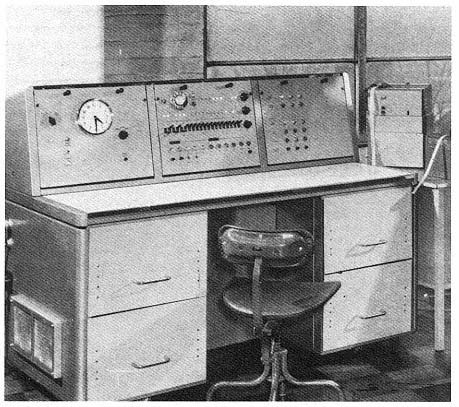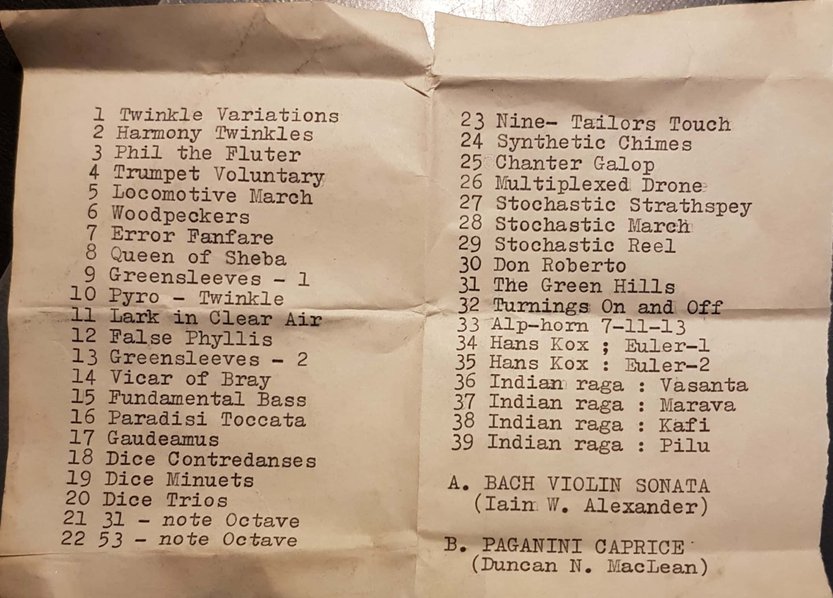SOLIDAC and Tom O'Bierne:
A computer from the 1950s and the man who made it play music
With all the modern hype about “AI” people will not be surprised if computers start to behave with personalities like real people. But this is a tale from the days when computers had personalities all of their own, not simulated human ones. When their peripherals made exciting whirring sounds, when they blinked at you enticingly with an impressive array of flashing lights, and when you could TOUCH switches that were wired right to their very heart. Because in those days computers still had a heart, and real character.
Specifically, it is tale about the SOLIDAC computer, and its successes in early work on computer music. SOLIDAC was the first computer ever built in Scotland, in the period 1959-1963. I was just a couple of years older than SOLIDAC when we spent many happy hours together as I learned assembly language programming as part of my Computing Science course at Glasgow University, Scotland in the mid 1970s. SOLIDAC lived in the basement of a Victorian era terraced house that then housed the University’s Computing Science Department. In winter this could be a rather cold place, and SOLIDAC did not like the cold. My fellow students and I soon learned that certain types of minor malfunctions could be solved by turning up the heat on the room’s lonely gas heater (SOLIDAC’s only companion in the dark winter nights) and waiting for the room temperature to rise a little. SOLIDAC responded to a little love and care.
Tom with SOLIDAC in 1969.
It was at this time that I met Tom O’Beirne. He was one of my lecturers at the time, and taught me everything I know about low-level programming. He was involved with SOLIDAC right from its birth; he knew everything there was to know about it, and loved imparting his knowledge to students who showed interest. Tom was a real character, and I spent many hours talking with him about fascinating topics that strayed a little from what we were formally required to learn in our courses. One of these topics was computer music.
Tom had become fascinated by the possibilities of using SOLIDAC to play music. This was achieved by direct wiring into the guts of the computer so that a click was produced when a specific instruction was executed. By including that instruction in parts of the computer program that repeated, tones could be produced. And by including those instructions in sequences, melodies could be produced. When Tom first got interested in something, he really got into it, so he experimented a lot in this area, at a time when computers were not very much in the public attention, let alone computers as musical instruments. One particular challenge he set himself was to try to make SOLIDAC make bagpipe-like sounds, and he succeeded in this!
Tom understood way back then that I found all this very interesting, and gave me a personal gift that I very much appreciated: a cassette tape with examples of a wide variety of the music that had been produced by SOLIDAC, and a 40 minute public lecture that he had given explaining all about his work. He also prepared a simple “Index Card” for the cassette, identifying the titles of all the musical pieces that were provided. Of course, I listened to this at the time (somewhere around 1977), but over the years I forgot all about it, and the SOLIDAC tape ended up being stashed away with other memorabilia and gathered dust.
In March 2018, I happened to get in touch with another of my former lecturers from Glasgow University – Bill Findlay. Bill is also a SOLIDAC fan, and his website includes lots of interesting technical information about SOLIDAC: http://www.findlayw.plus.com/SOLIDAC/index.html In discussion with Bill I learned that he too had received a collection of SOLIDAC music from Tom, but had lost it completely long ago. This news encouraged me to do a search in numerous boxes in my garage. In the way these things work, I failed – of course – to find the cassette. But some weeks later, when searching for something else completely, I was delighted to come across the undamaged cassette. I immediately created a digital version, and that is the reason this web page came into existence.
I don’t know if there are other copies of the SOLIDAC music, or the lecture, anywhere else. Nor do I know whether anyone is even interested. But I feel it would be a great shame if this were lost. And I feel I owe it to Tom for his work to be allowed to live on. Thus, in memory of Tom, and in memory of SOLIDAC, I here include all the music (as separate tracks in MP3 format), and Tom’s engaging lecture about his work.
As a footnote I should mention that an LP was produced in 1967 with music from SOLIDAC entitled “DICE-Composition Music”. See: https://physicalimpossibility.com/2013/01/05/1967-computer-music-produced-in-glasgow/ for information about the LP, together with a copy of its musical content. This is rather different to the music presented here: it consists mostly of short pieces generated using random choices from a basic pattern. I don’t know of any other SOLIDAC music being available anywhere else.
If you would like to receive sound files with SOLIDAC music, or of a TV lecture by Thomas O'Beirne, please make a request using the CONTACT form.


